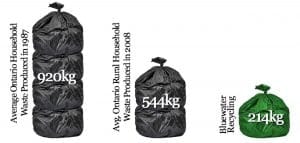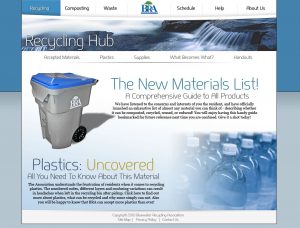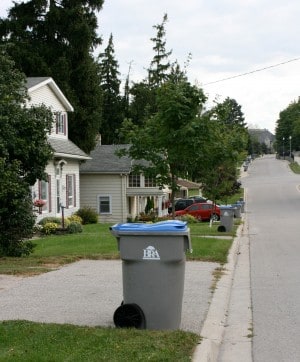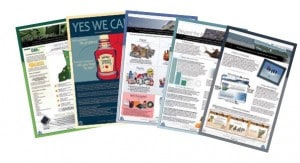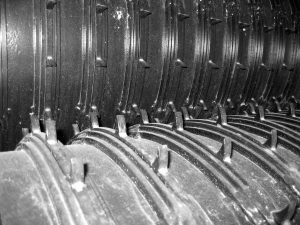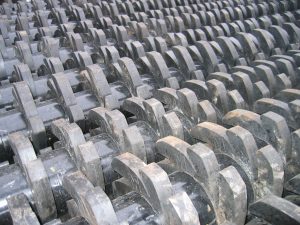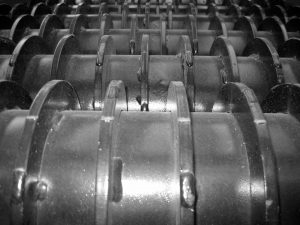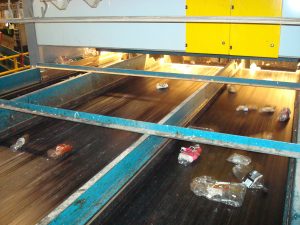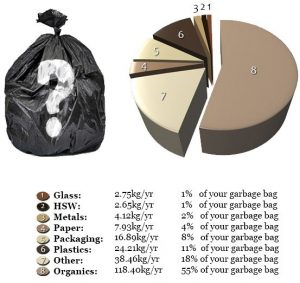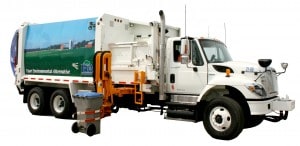In the Spotlight
Bluewater Recycling Association: Putting Power in the Community’s Hands
Because Bluewater Recycling Association households currently generate 77 percent less waste today than it did 25 years ago, the organization has stepped up its game and focused on the adoption of higher recycling goals.
Established in 1989, the Bluewater Recycling Association (Huron Park, ON) is a rural-based, non-profit organization developing and maintaining facilities on behalf of, and in cooperation with, the municipal sector. The Association owns a state-of-the-art single-stream 50,000 tons per year material recovery facility (MRF) and a fleet of 42 collection vehicles. The 68 people employed by the Association handle more than 29,000 tons of material annually, which represents a substantial portion of the overall waste stream. The Association services approximately 160,000 people in 70,000 households from 22 municipalities in four counties in Southwestern Ontario, Canada, covering approximately 3,300 square miles—about the size of the State of Delaware and Rhode Island combined.
The Association’s primary focus has always been waste diversion since the organization does not own or operate any disposal facilities. Given the rural nature of the service area, most of the materials are generated by residential properties with some small commercial, industrial and institutional sources. Recyclables accepted in the program include: newsprint and paper, corrugated cardboard, LDPE, aluminum containers, ferrous containers and plastic bottles (see Accepted Recyclables sidebar, page xx). There are also special programs for electronic waste and organics materials (see Special Programs sidebar, page xx).
Transitioning the Sorting Process
According to Francis Veilleux, President of the Bluewater Recycling Association, the local economy has been good in the last couple of years. However, they were severely impacted in 2009 when commodity prices collapsed causing a $1 million shortfall in revenue. “Nobody escaped that one,” he says. Veilleux pointed out that they did understand that the collapse was temporary and took the opportunity to make a $5 million investment in their MRF. “We had been working on a single-stream design using a different approach and the economic slow down was the perfect time to implement it.”
Veilleux explains that the traditional approach to material sorting has been mainly driven by people lined around conveyors manually separating different commodities to meet market demands. “This approach was rudimentary and effective when only five materials were collected curbside. However, applying this approach to today’s material mix is accepting that material quality is not important, high sorting costs are acceptable, and repetitive strain injuries are normal. We do not support this approach to processing,” says Veilleux.
“While the Association is proud of its past developments in the material recovery facility, the future of our industry demands higher throughput and a higher quality standard with a broader mix of materials. The ever-changing packaging stream makes it a necessity to use technology to assist in the sorting activity, as our people cannot physically and mentally process what is presented to them today in a speed necessary to be effective. You cannot expect any sorter to know that a specific shampoo bottle may be made in any of three different resins and expect quality commodities,” he says.
He goes on to explain that in the early 1990s, a PET bottle was essentially a 2L soft drink container. They were easy to identify and quantities were manageable to manually sort after some basic screening. After a local water contamination incident killed seven people in 2000, single serve PET water bottles proliferated the market place. The impact at the MRF was an increase in bottles managed from 500,000 per year to over 25 million. As a result, the use of people to manually sort materials, resulting in repetitive strain injuries, was not sustainable. The average human hand can effectively pick 1,500 pieces an hour. It is impossible to manually sort a much higher volume and maintain quality without mechanical assistance. So, in 2008 the Association made the decision to invest in an optical sorter that can process in excess of 500,000 pieces per hour. Employees were naturally concerned about the changes initially but they quickly embraced the improvement in working conditions. It is much more interesting to manually fix the 2 to 5 percent mistakes the machine does, than to attempt to do 100 percent of the workload. “The latest technological advances in our industry have enabled us to effectively change the treatment approach of recyclables where technology does the sorting and our people focus on quality,” says Veilleux.
Challenges and Achievements
Different times have provided different challenges. Veilleux points out that in the early days of the Association, getting the financing they needed to even get the organization started and later fuel its growth was extremely difficult. “Bankers don’t like the word non-profit. We kept looking until we found one that saw beyond those two words and we have been doing business ever since.”
Veilleux explains that the Association was created in 1989 to divert materials from landfill and this remains their primary focus today. “In fact, our operational license restricts the residue rate to less than 10 percent. The Association does not own or operate any landfills and as such any disposal is a cost to us. Over the last five years, our average residue rate has been 3.38 percent. The current residue rate is less than 2.7 percent, while our commodities average a purity rate better than 98 percent.”
Veilleux also understands that markets have always had ups and downs and always will, including the supply and demand cycle of commodities. The Association tries to insulate itself as much as possible by becoming premium suppliers to few buyers with their consistent quality commodities. “We value our relationships more than the odd dollar found on spot markets in good times. We also do not believe in status quo. There is always room for improvement. We are continuously evaluating new technologies and methodologies to improve what we do today. When trying something new we know that if it doesn’t work, we can always do it the old way,” he says.
Managing Recyclables
The Association uses a systematic approach to material management. Despite operating a single-stream system, Veilleux points out that curbside preparation and collection methodology are equally important factors in achieving the best quality while minimizing residue. “Once in the MRF, we use four treatment methods to extract the most materials while achieving the most value through quality management. The facility processes single-stream materials using equipment such as five screens, five air classifiers, two optical sorters, two overhead magnets and two eddy currents to separate the materials with the assistance of personnel in a quality control role only.” While the changes have improved the efficiency of the systems, they also enhanced the quality of the jobs and the safety of our employees.
The Association has researched and experimented with numerous technologies and processes over the last two decades to come up with a combined package that maximizes throughput, flexibility, and quality while minimizing labor and capital costs. Some of the unique and innovative components of the system include:
A glass cleaning system that removes the glass early in the system with an overhead magnet, an eddy current and uses a cyclone-based vacuum system applied to selective particle sizes generated by a trommel for maximum efficiency and ensures that clean glass is generated without relying on failure prone rotary valves or expensive optical systems.
The container sort area uses the widest optical system in North America measuring more than 9 feet across and is the first triple pass optical system in Ontario on one machine. Three separate passes are used to separate the material stream into up to seven categories. The three passes offer a greater flexibility of material selection for sorting as the mix changes. The best part is the third pass. After achieving a 95 percent purity level on the first and second pass, the PET and HDPE are batched processed on the third pass to achieve a 99 percent material purity right out of the machine. The QC sorter can concentrate on non-bottle contamination until such time as end markets can accept them.
Another innovative design in this single-stream facility is the mixed fiber process. An optical separator is used to remove non-fiber contamination (plastic, metal) from the mixed fiber. Any paper removed with the containers is easily recovered with a strategically placed low-pressure air classifier effectively separating the paper from the containers. All plastics and metals removed are redirected to the “container” line after being cleaned by the air classifier.
Using this approach, the Association has not recorded a single rejection or downgrade since 2006.
Although the Association does not make any end products, the materials collected are sold to buyers for which they have established long-term relationships. These buyers have usually visited their facility and observed the material process and identified a useful end product being manufactured. In order to encourage a “local” economy and reduce their carbon footprint, preference is given to Ontario-based markets. In the absence of reasonable “local” markets, they sell to other Canadian or U.S. buyers to ensure that the highest value for their quality recyclables is received. The export of materials overseas is generally not a preferred option.
Educating the Public
Part of the Association’s mission is to ensure that consumers make informed decisions and as a result, not only have they developed a Web site with hundreds of pages dedicated to accomplish just that, but they also have developed a number of publications to educate everyone about waste management activities. “Education is what makes us different. We are much more than the company collecting and processing your recyclables. Whether it’s our award winning newsletter or some of the 800 pages of school curriculum we have published, we have information for everyone,” points out Veilleux.
Although the Association does not operate under the pressure of meeting shareholder’s return on investment targets and the bottom line is not a priority, they do respect the need to be fiscally responsible while providing the best service achieving the highest level of diversion. “Since we don’t own or operate any disposal facilities, our focus remains on waste diversion initiatives and education is an important component of our offering.
We act as the waste diversion department for each of our member municipalities enabling them to focus on other important issues in your community,” says Veilleux. “We provide the tools to maximize waste diversion, whether it is the free replacement recycling bins, award winning newsletters, an informative Web site with locally relevant information, our toll free number with knowledgeable staff, composters, digesters, Christmas tree chippings and so much more.”
The Association also lobbies on behalf of the municipalities, reports to authorities waste initiatives, reports to members their progress to meet their environmental commitments and provides the most innovative, effective and efficient programs available. The Association also sends people out into the community to make presentations, attend fairs and participate in parades.
Moving Forward
The adoption of higher recycling goals has caused communities to target more materials for collection, exacerbating the problems associated with curb-sort collection systems (e.g., limited number and size of compartments, limited bin capacity, etc.). Veilleux says, “In the last 20 years or so, there has been significant growth in the use of automated refuse collection vehicles for both refuse and recyclables collection. The growth of this market has resulted in design improvements that have increased the reliability and reduced the maintenance costs of automated collection equipment, as well as lowered equipment prices.”
The traditional collection system was manual-based. Residents set out their waste in bags with bag tags and the recyclables were set out in 18 gallon blue boxes. The materials were then collected with a split side loader with one driver/operator manually loading the contents into the vehicle. Now,the Association is currently in the process to convert 90 percent of its customers to a fully automated collection system to reduce collection costs because:
Each driver is more productive because there is less sorting to do at the curb. A single-stream vehicle can collect up to 180 households per hour whereas a dual stream truck can only collect 80 to 120 households per hour.
Each vehicle can fully use its capacity and avoid the typical compartment “cube-out” issues associated with multiple sorts. Routes can be larger with fewer vehicles.
With the larger containers provided to the residents, even collection frequency can be reduced to save even more.
Residents benefit with having bins that are up to six times the capacity of the blue box that facilitates and encourages more recycling. There has been a 17 to 33 percent increase where implemented.
The fixed wheels make hauling them to the curb a lot less work than before.
Using bins with lids helps to keep water, ice, and snow from set-outs, which helps to control the water contamination and helps the sorting process.
Discourages scavenging of valuable materials.
Using bins can improve neighborhood aesthetics—uniform containers often eliminate unsightly set-outs.
Blowing litter can be reduced because containers with lids are more resistant to being tipped over or torn apart by dogs, raccoons, crows, etc.
Ability to use standardized collection trucks.
High public approval because it’s so easy and convenient.
Reduced health and safety risks to workers.
Wider range of workers qualifying for the automated collection jobs.
Greater efficiency and productivity.
Lower costs, including cost savings on worker compensation
Although items such as styrofoam packaging, milk cartons and tetra pak juice boxes are often cited as materials missing from the Association’s program, they only make up less than 1 percent of the waste disposed and have limited or no markets available on top of having enormous costs associated with them. On the other hand, the results clearly show that organic materials (food, etc.) make up the majority of the average garbage bag, with developing markets and a cost to manage set slightly higher than waste disposal. Therefore, it is more than likely that the Association’s next major focus on waste reduction will be centered on organics recycling. Despite their best efforts to reduce, reuse and recycle as much as possible, organics still remain the largest fraction in the waste bags. The technologies to manage this stream are readily available, but disposal costs are still too low to make it economically viable. “Until our governments use policies such as landfill taxes like in Europe, it will be difficult to make any headway in this direction,” says Veilleux.
However, on a positive note, the average Association household currently generates 77 percent less waste today than it did in 1987. The amount of waste generated by the average household in 1987 was nearly 1 ton. In 2008, the average rural household in Ontario disposed about 1,200 lbs. “We are now proud to report that our average households are disposing a mere 472 lbs. per year. These numbers are not only impressive, but some of the best in Ontario and Canada exceeding all goals,” says Veilleux. “The main reason we were able to reach this goal is because our members implemented pay-as-you-throw programs that provided the incentive for residents to use the waste diversion tools available to them.” The current Ontario government goal was to reduce the amount of waste disposed by households by 60 percent (811 lbs.) by 2008. Says Veilleux, “The Association is far beyond that goal, and aims to push the envelope even further.”
For more information, contact Francis Veilleux, President of the Bluewater Recycling Association Huron Park, at (519) 228-6678, e-mail [email protected] or visitwww.bra.org.
Captions
Waste diversion accomplishment by the Bluewater Recycling Association.
Bluewater Recycling Association comprehensive web site.
Automated collection is a clean, safe, and efficient way to collect recyclables.
Pages from the Association’s bi-annual newsletter.
Perforator used to remove liquids from containers and crush glass.
Rubber disks used in a finishing screen to separate containers from paper.
Disk screen to remove small fraction
Triple pass, triple chanel optical sorter making a half a milion ejections per hour.
Current waste composition of the average household at Bluewater (waste bag only).
Automated collection vehicle used by the Bluewater Recycling Association.
Photos courtesy of the Bluewater Recycling Association.
Sidebar
Quality Assurance
The Association’s MRF is one of the few in the industry that maintains a quality assurance program. Their program is an integral part of the overall system. Quality assurance entails every part of the program, including:
Easily accessible and user-friendly educational materials on acceptable materials and proper material preparation for users. The Association can assist in the development of educational materials and can do their own desktop publishing and manages their Web site with more than 1,500 pages.
Enforced program rules by the driver responsible for collecting the materials.
Effective vehicle design to keep materials intact to facilitate separation.
Predictable materials flow design in the recovery facility.
Optimum materials separation methodology using the latest technology to handle the commodities.
Use material handlers to ensure material quality throughout the process.
Perform secondary quality inspection prior to baling.
Inspect materials prior to storage for shipment approval or rejection
Collect samples and test against industry standards.
Review external quality control tests against internal sample and resolve discrepancies.
Sidebar
Special Programs
Electronics
The Association collects electronic waste through permanent depots and special events held at different smaller locations. The same wide variety of electronic waste accepted by the permanent depot was accepted during those events. The electronic waste ranges from old televisions to radios, cell phones, computers, telephones, fax machines, and all sorts of unique electronics. Nearly 750,000 pounds of electronic waste have been recovered to date.
Organics
The best way to manage organics is close to home. The Association provides two solutions for its residents to manage organics, a backyad composter (Garden Gourmet) and a food digester (Green Cone). They each sell for $50 and $90 respectively. Since most municipalities charge for waste by the bag, they can save each household up to $50 a year in waste management fees.

